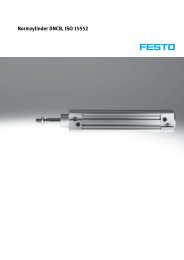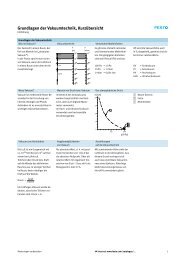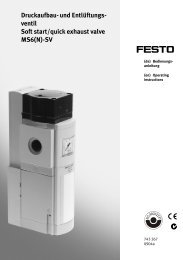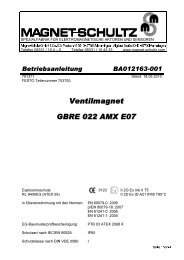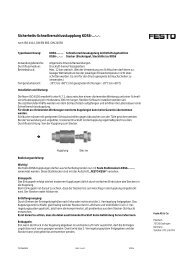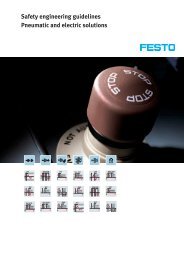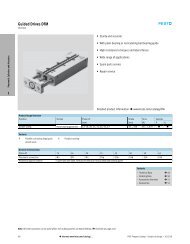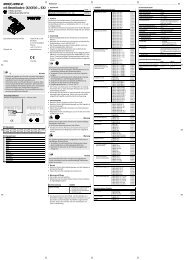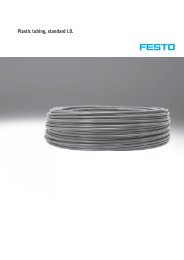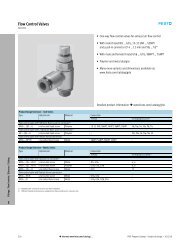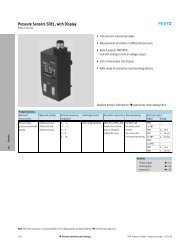Download latest edition - Festo
Download latest edition - Festo
Download latest edition - Festo
You also want an ePaper? Increase the reach of your titles
YUMPU automatically turns print PDFs into web optimized ePapers that Google loves.
The skin is the most important<br />
organ in the human body. The<br />
production of tissue models<br />
for testing medical treatments<br />
is therefore very complex. Until now,<br />
skin equivalents for transplants or for<br />
verifying the compatibility of active<br />
ingredients in medicines, cosmetics and<br />
chemicals were only produced manually<br />
on a laboratory scale. Culturing took<br />
a whole six weeks. Using this method,<br />
it was generally not possible to produce<br />
more than 2,000 pieces of skin per<br />
month, each measuring a square centimetre.<br />
This is certainly not the case in<br />
the new “Tissue Factory” at the BioPoLiS<br />
bioproduction laboratory of Fraunhofer<br />
IPA. It is the world’s fi rst facility with fully<br />
automated in vitro production, producing<br />
up to 5,000 thumbnail-sized skin models<br />
per month.<br />
Seamless automation<br />
The facility for the production of skin<br />
equivalents is a fl agship project in the<br />
area of bioproduction, which is the symbiosis<br />
of biology and automation technology.<br />
The interdisciplinary cooperation<br />
between biologists and engineers led to<br />
an unprecedented degree of automation<br />
in tissue engineering. The seamless automation<br />
of all process steps facilitated<br />
the introduction of new production and<br />
fi nancial standards such as reproducible<br />
quality, throughput and cost optimisation<br />
in skin model construction.<br />
Faster production<br />
To produce around 5,000 skin models<br />
per month, biological requirements with<br />
regard to the sterility of all processes<br />
and the handling of cells must be met.<br />
This involves a multi-stage process<br />
in which the skin samples are fi rst<br />
sterilised, transported to the system by<br />
robot, broken down, isolated and cultivated<br />
in a special culture medium under<br />
constant ambient conditions. The cells<br />
are then grown in a 3D gel matrix in two<br />
layers. The skin equivalent is ready for<br />
use after just three weeks. In accordance<br />
with the principles of hygienic design,<br />
the developers of the tissue factory<br />
aimed for a continuous process chain.<br />
Cell extraction and proliferation as well<br />
as three dimensional tissue formation<br />
are carried out in a seamless sequence<br />
in a single system. The process incorporates<br />
more than 100 <strong>Festo</strong> components,<br />
including compressed air preparation,<br />
sensors, cylinders, electric axes, servo<br />
and stepper motors as well as fastswitching<br />
valves and the valve series<br />
VUVG. The majority of these components<br />
are found in the cell extraction<br />
process. Where the products are part<br />
of the production space, clean room<br />
components are used. The decapper<br />
operates as a complete system and is<br />
responsible for unscrewing lids.<br />
Future-proof<br />
The bioproduction of tissue engineering<br />
products is already a hugely important<br />
area in biotechnology. It allows tissue to<br />
be produced in larger quantities and thus<br />
represents a major step forward in cell<br />
research. This new technology paves the<br />
way for an end to animal testing of products<br />
to check the skin tolerance level.<br />
In regenerative medicine, skin equivalents<br />
are helping an increasing number of people,<br />
for example with wounds that are<br />
not healing properly. In future, scientists




